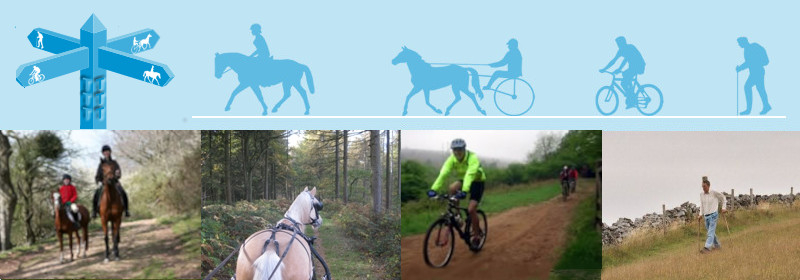The Trails Trust (TTT) is a registered charity and a company limited by guarantee. It is administered by a Management Board of Trustees. Membership is open to anyone with an interest in the creation of rights of way through a legal process known as express dedication at common law (EDCL).
Express Dedication at common law can be used to create all three classes of rights of way (highways) – footpath, bridleway and carriageway.
Creation of a highway (right of way) by express dedication at common law depends upon dedication to the whole public of a permanent route / rights by the landowner(s) and acceptance by the public. The public shows acceptance through use.
The process offers multiple benefits over statutory creation processes to users, landowners and local highway authorities in terms of reduced costs and liability, expediency and co-operation.
There are a number of useful documents explaining or supporting the process and what needs to be done. These are free to download and include:-
- 2012 TTT Guide – creating multi user public rights of way – a guide for local groups (R Thompson)
- 2012 Defra Guidance to Natural England on the principles of express dedication (D Waterman)
- 2012 / 2013 Public Inquiry and appeal papers. Inquiry into an express dedicated bridleway at Upper Vobster in Somerset (P Millman /H Cruickshank)
- 2017 The Trails Trust and the Creation of Highways advice note (M White – St John’s Chambers)
- 2017 The Creation of Highways (R Thompson TTT in conjunction with the British Horse Society)
- 2018 TTT response to the Agriculture Bill Scrutiny Committee
Creation of a highway through the common law process does not require the consent of the local highway authority (LHA). However once the LHA is satisfied that footpath, bridleway or carriageway rights have been created it is obliged by law to show the new rights / route on the Definitive Map and Statement (DMS). The LHA has duties and powers with regard to the new route, whether or not it is recorded on the DMS.
TTT supports and advises groups and individuals seeking to create safe linear or circular community routes by using highway creation as the mechanism for providing missing links, routes required for safety reasons or any other route needed.
Highway creation (if agreed) can happen more or less immediately. Using this process it is possible to:
- Create an entirely new right of way – footpath, bridleway or carriageway in order to provide a missing link or (for example) over the hedge (safety) route
- Upgrade an existing right of way – for example create bridleway rights over an existing footpath route or carriageway rights over an existing footpath or bridleway route
- Establish a right of way over a corridor of apparently unowned land such as green lanes and droves, negating the need to produce historical or user evidence which may be difficult to find.
- Rededicate an evidence based historic route of any sort- avoiding a lengthy, time consuming DMS application.
This approach was promoted and used in the Government’s Paths for Communities Scheme (P4C 2012 – 2014). The scheme promoted the use of the TTT guide “Creating Multi-user Public Rights of Way” to those wishing to create multi user paths (bridleways) through the scheme. (This publication was supported by Natural England and Department for Environment, Food and Rural Affairs).
.

